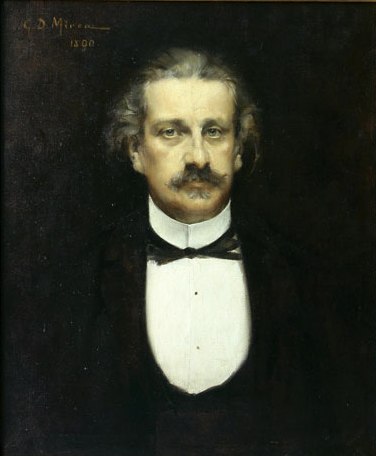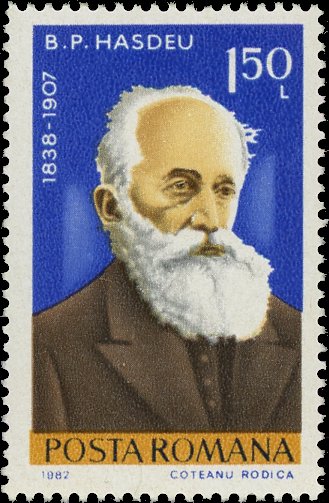|
Românul
''Românul'' (, meaning "The Romanian"; originally spelled ''Romanulu'' or ''Românulŭ'', also known as ''Romînul'', ''Concordia'', ''Libertatea'' and ''Consciinti'a Nationala''), was a political and literary newspaper published in Bucharest, Romania, from 1857 to 1905. Established as the leading voice of Liberalism and radicalism in Romania, Romanian liberalism (the "Red" faction) in the state of Wallachia, it had direct connections to the Radicalism (historical), radical ideology of Western Europe. Its founder and director was the aristocrat C. A. Rosetti, known as Romanticism, Romantic poet, Freemasonry in Romania, Masonic promoter and left-wing activist, seconded by the brothers Ion C. Brătianu and Dimitrie Brătianu. ''Românul''s roots were planted in the Wallachian Revolution of 1848, 1848 revolutionary movement, whose press organ, ''Pruncul Român'', was a direct predecessor. In its first editions, ''Românul'' helped circulate the slogans of the national emancipation id ... [...More Info...] [...Related Items...] OR: [Wikipedia] [Google] [Baidu] |
Maria Rosetti
Princess Maria Rosetti (born Marie Grant; 1819 – ) was a Guernsey born Wallachian and Romanian political activist, journalist, essayist, philanthropist and socialite. The sister of United Kingdom of Great Britain and Ireland, British diplomat Effingham Grant and wife of Liberalism and radicalism in Romania, radical leader C. A. Rosetti, she played an active part in the Wallachian Revolution of 1848. She was also noted for her enduring friendships with the painter Constantin Daniel Rosenthal and with Pia Brătianu, the wife of National Liberal Party (Romania, 1875), National Liberal politician Ion Brătianu. The Rosettis were parents to eight sons: Mircea Rosetti, Mircea, Ion, Vintilă Rosetti, Vintilă (journalist and writer), Horia Rosetti, Horia, Elena-Maria, Toni, Floricel and Libertatea Sophia, all of whom were noted for their political activities. Biography Born to Captain Edward Grant, a ship-owning resident of Guernsey, and his Guernsey wife Marie Le Lacheur, Marie belong ... [...More Info...] [...Related Items...] OR: [Wikipedia] [Google] [Baidu] |
Wallachian Revolution Of 1848
The Wallachian Revolution of 1848 was a Romanian liberal and nationalist uprising in the Principality of Wallachia. Part of the Revolutions of 1848, and closely connected with the unsuccessful revolt in the Principality of Moldavia, it sought to overturn the administration imposed by Imperial Russian authorities under the '' Regulamentul Organic'' regime, and, through many of its leaders, demanded the abolition of boyar privilege. Led by a group of young intellectuals and officers in the Wallachian Militia, the movement succeeded in toppling the ruling Prince Gheorghe Bibescu, whom it replaced with a provisional government and a regency, and in passing a series of major progressive reforms, announced in the Proclamation of Islaz. Despite its rapid gains and popular backing, the new administration was marked by conflicts between the radical wing and more conservative forces, especially over the issue of land reform. Two successive abortive coups were able to weaken th ... [...More Info...] [...Related Items...] OR: [Wikipedia] [Google] [Baidu] |
Republicanism
Republicanism is a political ideology that encompasses a range of ideas from civic virtue, political participation, harms of corruption, positives of mixed constitution, rule of law, and others. Historically, it emphasizes the idea of self-governance and ranges from the rule of a representative minority or aristocracy to popular sovereignty. It has had different definitions and interpretations which vary significantly based on historical context and methodological approach. In countries ruled by a monarch or similar ruler such as the United Kingdom, republicanism is simply the wish to replace the hereditary monarchy by some form of elected republic. Republicanism may also refer to the non-ideological scientific approach to politics and governance. As the republican thinker and second president of the United States John Adams stated in the introduction to his famous '' A Defense of the Constitutions of Government of the United States of America'', the "science of politics ... [...More Info...] [...Related Items...] OR: [Wikipedia] [Google] [Baidu] |
Alexandru Odobescu
Alexandru Ioan Odobescu (; 23 June 1834 – 10 November 1895) was a Romanian author, archaeologist and politician. Biography He was born in Bucharest, the second child of General Ioan Odobescu and his wife Ecaterina. Ecaterina belonged to the Caracaș family, originally from modern northern Greece. After attending Saint Sava College and, from 1850, a Paris ''lycée'', Alexandru Odobescu took the ''baccalauréat'' in 1853 and studied literature and archaeology at the University of Paris, graduating two years later. In 1858, he married Pavel Kiselyov's daughter Alexandra (Sașa) Prejbeanu; they had one daughter, Ioana. He was often apart from his wife and had affairs with other women. Odobescu served as cabinet minister for religion and education in 1863, as head clerk at the Ministry of Foreign Affairs in 1865, and as prosecutor at the Court of Appeal. In 1870, he travelled in Switzerland and Italy, in connection with his discovery and description of the Pietroasele treasure, ... [...More Info...] [...Related Items...] OR: [Wikipedia] [Google] [Baidu] |
Bogdan Petriceicu Hasdeu
Bogdan Petriceicu Hasdeu (; 26 February 1838 – ) was a Romanian writer and philologist who pioneered many branches of Romanian philology and history. Life He was born Tadeu Hâjdeu in Cristineștii Hotinului (now Kerstentsi in Chernivtsi Oblast, Ukraine), northern Bessarabia, at the time part of Imperial Russia. His father was the writer Alexandru Hâjdeu, a descendant of the Hâjdău family of Moldovan boyars, with noted Polish connections. Alexandru's mother was Jewish. After studying law at the University of Kharkiv, he fought as a Russian hussar in the Crimean War. In 1858, he settled in Iași as a high school teacher and librarian. In 1865, Hasdeu published a monograph on Ioan Vodă the Terrible, renaming him for the first time ''cel Viteaz''—"the Brave". The portrayal of this violent, short rule as a glorious moment (and of Ioan himself as a reformer) drew criticism from the '' Junimea'' society, a conflict which was to follow Hasdeu for the rest of his life. ... [...More Info...] [...Related Items...] OR: [Wikipedia] [Google] [Baidu] |
Ottoman Empire
The Ottoman Empire (), also called the Turkish Empire, was an empire, imperial realm that controlled much of Southeast Europe, West Asia, and North Africa from the 14th to early 20th centuries; it also controlled parts of southeastern Central Europe, between the early 16th and early 18th centuries. The empire emerged from a Anatolian beyliks, ''beylik'', or principality, founded in northwestern Anatolia in by the Turkoman (ethnonym), Turkoman tribal leader Osman I. His successors Ottoman wars in Europe, conquered much of Anatolia and expanded into the Balkans by the mid-14th century, transforming their petty kingdom into a transcontinental empire. The Ottomans ended the Byzantine Empire with the Fall of Constantinople, conquest of Constantinople in 1453 by Mehmed II. With its capital at History of Istanbul#Ottoman Empire, Constantinople (modern-day Istanbul) and control over a significant portion of the Mediterranean Basin, the Ottoman Empire was at the centre of interacti ... [...More Info...] [...Related Items...] OR: [Wikipedia] [Google] [Baidu] |
Austrian Empire
The Austrian Empire, officially known as the Empire of Austria, was a Multinational state, multinational European Great Powers, great power from 1804 to 1867, created by proclamation out of the Habsburg monarchy, realms of the Habsburgs. During its existence, it was the third most populous monarchy in Europe after the Russian Empire and the United Kingdom of Great Britain and Ireland, United Kingdom, while geographically, it was the third-largest empire in Europe after the Russian Empire and the First French Empire. The empire was proclaimed by Francis II, Holy Roman Emperor, Francis II in 1804 in response to Napoleon's declaration of the First French Empire, unifying all Habsburg monarchy, Habsburg possessions under one central government. It remained part of the Holy Roman Empire until the latter's dissolution in 1806. It continued fighting against Napoleon throughout the Napoleonic Wars, except for a period between 1809 and 1813, when Austria was first allied with Napoleon ... [...More Info...] [...Related Items...] OR: [Wikipedia] [Google] [Baidu] |
Bukovina
Bukovina or ; ; ; ; , ; see also other languages. is a historical region at the crossroads of Central and Eastern Europe. It is located on the northern slopes of the central Eastern Carpathians and the adjoining plains, today divided between Romania and Ukraine. Inhabited by many cultures and peoples, settled by both Ukrainians ( Ruthenians) and Romanians (Moldavians), it became part of the Kievan Rus' and Pechenegs' territory early on during the 10th century and an integral part of the Principality of Moldavia in the 14th century where the capital of Moldavia, Suceava, was founded, eventually expanding its territory all the way to the Black Sea. Consequently, the culture of the Kievan Rus' spread in the region during the early Middle Ages. During the time of the Golden Horde, namely in the 14th century (or in the High Middle Ages), Bukovina became part of Moldavia under Hungarian suzerainty (i.e. under the medieval Kingdom of Hungary). According to the Moldo-Russian Ch ... [...More Info...] [...Related Items...] OR: [Wikipedia] [Google] [Baidu] |
Transylvania
Transylvania ( or ; ; or ; Transylvanian Saxon dialect, Transylvanian Saxon: ''Siweberjen'') is a List of historical regions of Central Europe, historical and cultural region in Central Europe, encompassing central Romania. To the east and south its natural border are the Carpathian Mountains and to the west the Apuseni Mountains. Broader definitions of Transylvania also include the western and northwestern Romanian regions of Crișana and Maramureș, and occasionally Banat. Historical Transylvania also includes small parts of neighbouring Western Moldavia and even a small part of south-western neighbouring Bukovina to its north east (represented by Suceava County). Transylvania is known for the scenery of its Carpathian landscape and its rich history, coupled with its multi-cultural character. It also contains Romania's second-largest city, Cluj-Napoca, and other very well preserved medieval iconic cities and towns such as Brașov, Sibiu, Târgu Mureș, Bistrița, Alba Iuli ... [...More Info...] [...Related Items...] OR: [Wikipedia] [Google] [Baidu] |
Carol I Of Romania
Carol I or Charles I of Romania (born Karl Eitel Friedrich Zephyrinus Ludwig von Hohenzollern-Sigmaringen; 20 April 1839 – ), was the monarch of Romania from 1866 to his death in 1914, ruling as Prince (''Domnitor'') from 1866 to 1881, and as King from 1881 to 1914. He was elected Prince of the Romanian United Principalities on 20 April 1866 after the overthrow of Alexandru Ioan Cuza by a palace coup d'état. In May 1877, Romania was proclaimed an independent and sovereign nation. The defeat of the Ottoman Empire (1878) in the Russo-Turkish War secured Romanian independence, and he was proclaimed King on . He was the first ruler of the Hohenzollern-Sigmaringen dynasty, which ruled the country until the proclamation of a socialist republic in 1947. During his reign, Carol I personally led Romanian troops during the Russo-Turkish War and assumed command of the Russo/Romanian army during the siege of Plevna. The country achieved internationally recognized independence via the ... [...More Info...] [...Related Items...] OR: [Wikipedia] [Google] [Baidu] |
Alexander John Cuza
Alexandru Ioan Cuza (, or Alexandru Ioan I, also Anglicised as Alexander John Cuza; 20 March 1820 – 15 May 1873) was the first '' domnitor'' (prince) of the Romanian Principalities through his double election as Prince of Moldavia on 5 January 1859 and Prince of Wallachia on 24 January 1859, which resulted in the unification of the two states. He was a prominent figure of the Moldavian Revolution of 1848. Following his double election, he initiated a series of liberal and progressive reforms that contributed to the modernization of Romanian society and of state structures. As ruler of the Romanian Principalities, he supported a political and diplomatic activity for the recognition of the union of Moldavia and Wallachia by the suzerain Ottoman Empire and achieved constitutional and administrative unity between Moldavia and Wallachia in 1862, when the Romanian Principalities officially adopted the name Romanian United Principalities with a single capital at Bucharest ... [...More Info...] [...Related Items...] OR: [Wikipedia] [Google] [Baidu] |








